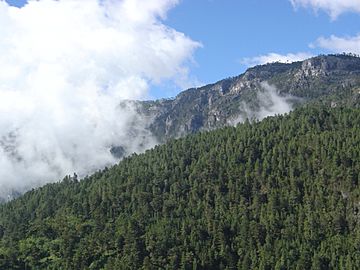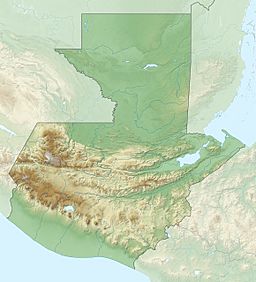Sierra de los Cuchumatanes facts for kids
Quick facts for kids Sierra de los Cuchumatanes |
|
|---|---|
 |
|
| Highest point | |
| Peak | La Torre (Todos Santos Cuchumatán) |
| Elevation | 3,837 m (12,589 ft) |
| Dimensions | |
| Area | 16,350 km2 (6,310 sq mi) |
| Geography | |
| Country | Guatemala |
| Geology | |
| Age of rock | Paleozoic to Mesozoic |
| Type of rock | Karst and sedimentary rock |
The Sierra de los Cuchumatanes is the highest non-volcanic mountain range in Central America. Its elevations range from 500 m (1,600 ft) to over 3,800 m (12,500 ft), and it covers a total area of c. 16,350 km2 (6,310 sq mi). With an area of 1,500 km2 (580 sq mi) situated above 3,000 m (9,800 ft), it is also the most extensive highland region in Central America. The Sierra de los Cuchumatanes is located in western Guatemala in the departments of Huehuetenango and El Quiché. Its western and south-western borders are marked by the Seleguá River, which separates it from the Sierra Madre volcanic chain. Its southern border is defined by the Río Negro, which flows into the Chixoy River, which turns northwards and separates the Cuchumatanes from the mountains in the Alta Verapaz region. The highest peaks, which reach up to 3,837 m (12,589 ft), are located in the department of Huehuetenango.
Etymology
The name "Cuchumatán" is derived from the Mam words cuchuj (to join or unite) and matán (with superior force) and means "that which was brought together by superior force". Cuchumatán may also be a derivation of the Nahuatl word kochmatlán, which means "place of the parrot hunters".
Climate
The Cuchumatanes has a variety of different biomes, including pine-oak lower montane and montane humid forest, while lower montane wet forest and neotropic grass- and shrublands are present on higher slopes and plateaus, and subtropical pluvial forest in the northern piemonte.
Some scholars say that the plants of Sierra de los Chuchumatanes are more like the plants in the Andes Mountains in South America than like plants in the rest of Mesoamerica due to the elevation and cool climate.
The area is dominated by páramo grasslands, but there are also stands of juniper and pines and forests of fir trees. Grazing from the sheep altered the area, causing both soil erosion and the depletion of the area's trees as the sheap feasted on new seedlings. Today, many of the area's trees grow in places that are too steep for sheep to reach.
Formation
The mountains formed during the Cretaceous Period. The Altos de Chiantla is a table-shaped land in the Sierra.
History
Historians believe that the Sierra and the Altos de Chiantla had few permanent residents before the Spanish came to Mesoamerica. They consider it possible that people planted potatoes, then left to live in nearby towns or villages, returning only at need. Scientists are not sure whether Mesoamericans brought potatoes to the Sierra or whether this did not occur until the Spanish arrived. It was not until the Spanish conquest, however, that the area came under intense cultivation. Potato farming either began or intensified, and sheep were introduced.
Economy
People in the Sierra de los Chuchumantanes grow potatoes and raise sheep. There is little of the maize cultivation that characterizes Mayan communities elsewhere.
There are hundreds of miles of stone fences in the Sierra to restrict the sheep. People place small soil islands on the tops of the stone fences to grow such plants as agave.
Many young people leave the Sierra to find work elsewhere. Some of them come to the United States. Many send remittances home to their families, who use the money to build pickup trucks and new houses and install irrigation and electricity. The trucks have allowed locals to seek better markets for their potatoes and wool.
Houses and buildings
Some people still live in Mayan-style houses with thatched roofs. But with young people sending money home, their families have built cinder block houses. These houses have roofs made of corrugated metal, and most of them have two stories. There are fewer rats in cinder block houses than in houses with grass roofs.
The traditional Mayan sweat bath is called a chuj. It is made of rock or adobe with a live sod roof. With young people sending money home, their families have built new chuj out of cinder blocks.
See also
 In Spanish: Sierra de los Cuchumatanes para niños
In Spanish: Sierra de los Cuchumatanes para niños


